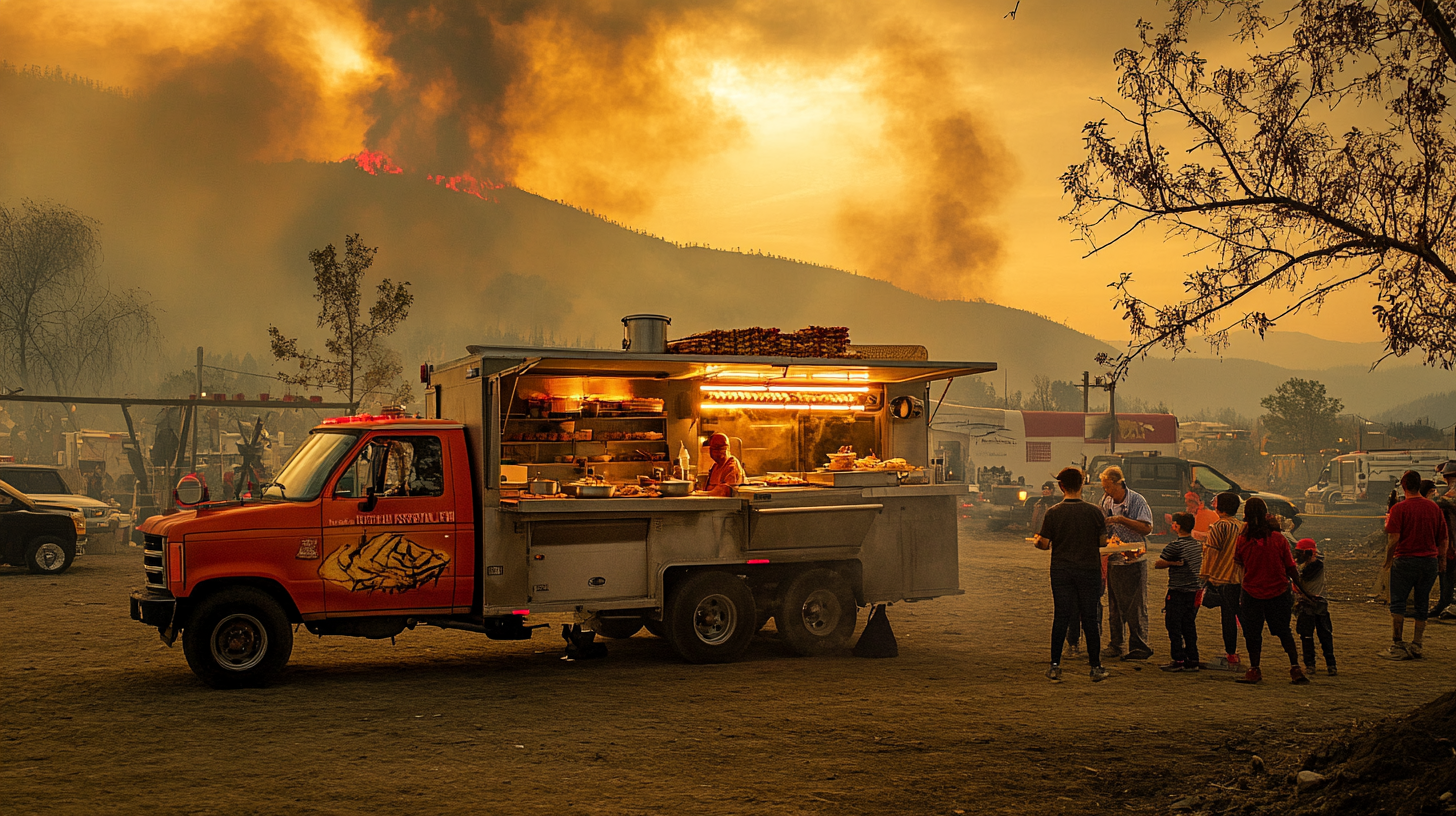Table of Contents
What Are Mobile Kitchens?

Let’s start with a simple question: What exactly are mobile kitchens? Picture a fully equipped kitchen on wheels, ready to whip up hot meals anywhere, anytime. These kitchens are built into trucks, trailers, or other mobile units and are specifically designed to cook, store, and serve food on the go. They’re the culinary superheroes of disaster relief, swooping in to save the day when communities need them most.
Mobile kitchens are often customized to meet specific needs. Some are outfitted with grills, fryers, and ovens, while others are focused on storage and distribution. Their versatility makes them indispensable in emergencies like wildfires, where traditional food systems may be disrupted.
The Evolution of Mobile Kitchens in Disaster Relief
Mobile kitchens weren’t always the sleek, efficient operations they are today. Back in the day, they were little more than basic food trucks, offering simple meals with limited capacity. Over time, however, technology and innovation have transformed them. Now, they’re capable of producing thousands of meals a day—hot, nutritious, and ready to eat.
During disasters like hurricanes, wildfires, and floods, mobile kitchens have become a lifeline, providing much-needed sustenance to displaced families and first responders. They’ve evolved from humble beginnings into high-tech hubs of hope.
The Growing Need for Mobile Kitchens in the United States
Analyzing the Impact of Wildfires on Communities
Wildfires are becoming more frequent and severe in the United States. States like California and Oregon have seen entire communities uprooted as flames devour homes and businesses. But it’s not just the physical destruction that’s devastating—it’s the toll on people’s well-being. Food insecurity skyrockets when grocery stores, supply chains, and local farms are disrupted.
Imagine losing your home and not knowing where your next meal will come from. That’s the harsh reality for many fire victims. Mobile kitchens step in to bridge this gap, ensuring no one goes hungry during such a crisis.
Statistics: Wildfires and Food Insecurity in the USA
Here’s a sobering fact: According to recent data, over 4.5 million acres were burned by wildfires in 2023 alone. Thousands of families were displaced, and food shortages became a critical issue. Food banks and shelters struggled to keep up, making mobile kitchens a crucial part of disaster response efforts.
“Wildfires don’t just destroy property—they shatter lives. Mobile kitchens offer a beacon of hope, serving hot meals and restoring a sense of normalcy.” – Disaster Relief Expert
The Role of Mobile Kitchens in Disaster Response
Providing Immediate Relief to Fire-Affected Communities

When disaster strikes, speed is everything. Mobile kitchens can be deployed within hours, bringing much-needed relief to areas hardest hit. They’re like food ambulances, arriving just in time to serve meals to hungry families and exhausted firefighters. These kitchens provide more than just food—they offer comfort and hope.
One of the most beautiful aspects of mobile kitchens is how they adapt to the situation. Whether it’s serving hearty stews during cold weather or fresh salads in the summer heat, they cater to the needs of the community. 🍲
Bridging Gaps in Traditional Food Distribution Systems
Traditional food distribution systems are great… until they’re not. During disasters, grocery stores run out of stock, supply chains are disrupted, and food banks can’t keep up. That’s where mobile kitchens shine. They’re independent and self-sufficient, able to step in when other systems fail.
Think of them as a pop-up restaurant, but with a heart. They go wherever they’re needed, from evacuation centers to remote rural areas, ensuring that no one is left behind.
How Mobile Kitchens Operate in Crisis Situations
Planning and Logistics for Effective Food Delivery
Running a mobile kitchen isn’t as simple as parking a truck and firing up the grill. It takes careful planning and coordination. Teams assess the needs of the community, identify suitable locations, and establish schedules for meal distribution. Communication is key to ensuring everything runs smoothly.
Key Equipment Used in Mobile Kitchens
Ever wondered what’s inside a mobile kitchen? Here’s a glimpse:
| Equipment | Purpose |
|---|---|
| Commercial Ovens | Baking and roasting large quantities |
| Refrigerators | Storing perishable ingredients |
| Grills and Fryers | Cooking meat and frying snacks |
| Food Warmers | Keeping meals hot and ready to serve |
| Generators | Providing power in remote locations |
These kitchens are like mini versions of your favorite diner, equipped to serve hundreds or even thousands of meals daily.
Staffing Mobile Kitchens: Volunteers and Professionals
Behind every mobile kitchen is a dedicated team of chefs, volunteers, and coordinators. Volunteers play a huge role, from chopping vegetables to handing out meals. Professionals ensure food safety standards are met and manage complex logistics. It’s a team effort that runs on passion and a commitment to helping others.
“Volunteers are the backbone of mobile kitchens. Without their hard work and dedication, these efforts wouldn’t be possible.” – Volunteer Coordinator
Challenges Faced by Mobile Kitchens
Limited Access to Affected Areas
Wildfires often make roads impassable, cutting off entire regions. Getting a mobile kitchen to these areas can be like threading a needle in a hurricane. Teams rely on local knowledge, GPS technology, and sheer determination to reach those in need.
Resource Constraints: Food, Equipment, and Funding
Mobile kitchens need resources to operate—lots of them. From fresh ingredients to fuel for generators, it’s a constant battle to secure what’s needed. Fundraising and donations play a crucial role in keeping these kitchens running.
Ensuring Food Safety and Hygiene in Emergency Situations
When you’re cooking for hundreds of people, food safety is non-negotiable. Mobile kitchens must adhere to strict guidelines to prevent foodborne illnesses. This means proper storage, cooking at the right temperatures, and regular cleaning. It’s hard work, but it’s essential to keep everyone safe.
Success Stories: Mobile Kitchens in Action
Case Study: Feeding Victims of California Wildfires
One of the most inspiring examples of mobile kitchens in action comes from California’s devastating wildfires in 2020. Entire neighborhoods were wiped out, leaving thousands without food or shelter. Mobile kitchens stepped in to provide hot meals, offering comfort and nourishment during an incredibly challenging time.
In one instance, a mobile kitchen team served over 10,000 meals in just a week, partnering with local farmers to source fresh ingredients. Their efforts didn’t just fill stomachs—they lifted spirits and reminded people that they weren’t alone.
“The meals weren’t just food; they were a reminder that someone cared. That’s the real power of mobile kitchens.” – Fire Survivor
Innovations That Made a Difference in Recent Disaster Responses

Technology has played a huge role in enhancing the efficiency of mobile kitchens. From GPS tracking to ensure timely delivery to portable solar-powered ovens, innovation has made these kitchens more effective than ever.
For example, during the 2021 Oregon wildfires, a nonprofit introduced a mobile kitchen with a built-in water filtration system. This allowed them to provide clean drinking water alongside meals, addressing two critical needs at once.
Common Problems in Mobile Kitchen Operations and Their Solutions
Overcoming Logistical Barriers
Logistics can be a nightmare during disasters. Roads are often blocked, and communication networks may be down. Mobile kitchens overcome these challenges through meticulous planning, real-time updates, and strong local partnerships. Collaborating with first responders and community leaders helps teams navigate tricky terrain and reach those in need.
Securing Adequate Funding and Support
Running a mobile kitchen isn’t cheap. It requires a steady stream of funding for ingredients, fuel, and maintenance. Crowdfunding campaigns, grants, and corporate sponsorships are some ways organizations secure financial support. Encouraging community involvement through donation drives and volunteer programs also makes a big difference.
Managing Burnout Among Volunteers
Volunteers are the heart and soul of mobile kitchens, but even they have limits. Long hours and high-stress environments can lead to burnout. To combat this, organizations implement rotating shifts, provide mental health support, and foster a strong sense of camaraderie among team members.
Conclusion: The Importance of Mobile Kitchens in Disaster Management
Reflecting on Their Role in Addressing Food Insecurity
Mobile kitchens are more than just vehicles; they’re a symbol of hope and resilience. By providing hot meals to those in need, they tackle food insecurity head-on and help communities recover from disasters.
A Call to Action for Strengthening Mobile Kitchen Networks
We all have a role to play in supporting mobile kitchens. Whether it’s through volunteering, donating, or simply spreading the word, every bit helps. Together, we can ensure these culinary heroes continue to make a difference in the lives of fire victims across the United States.

